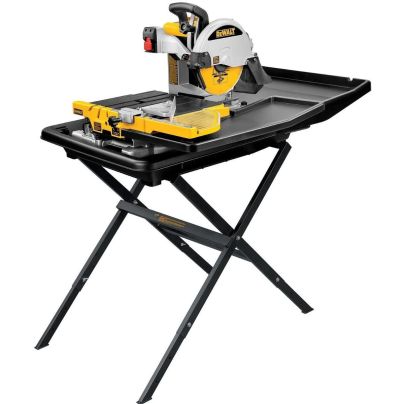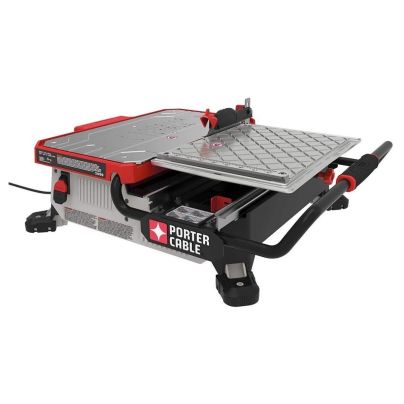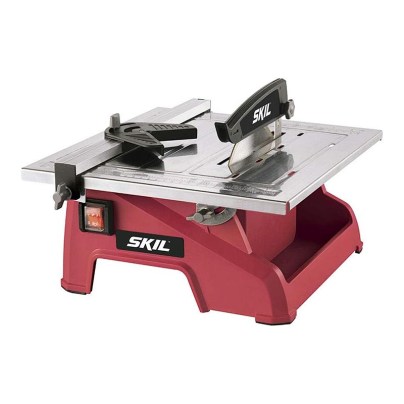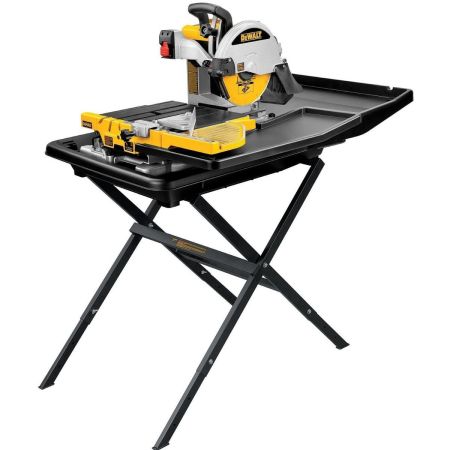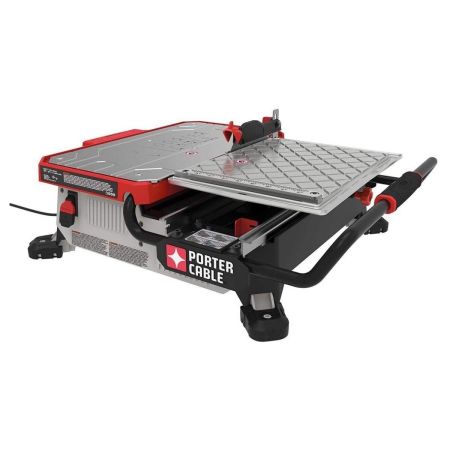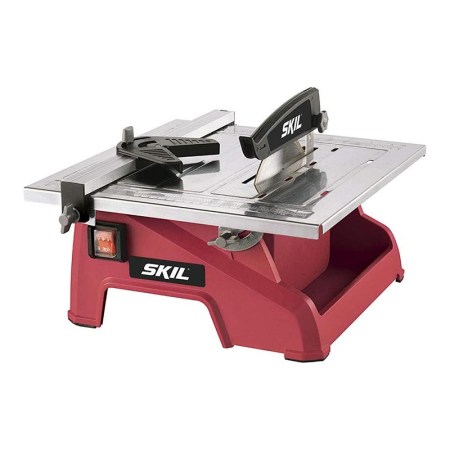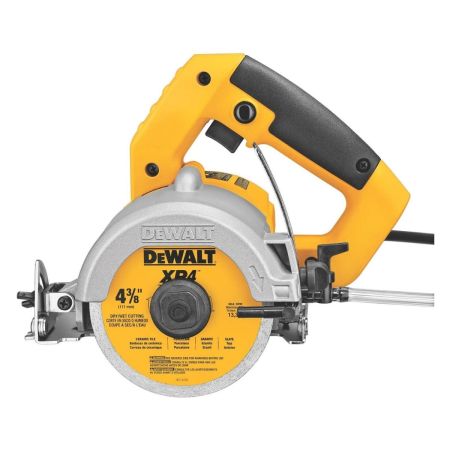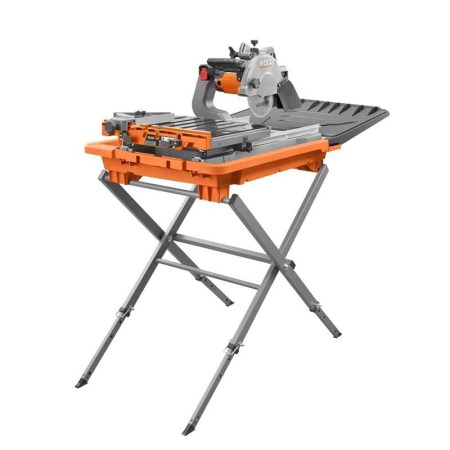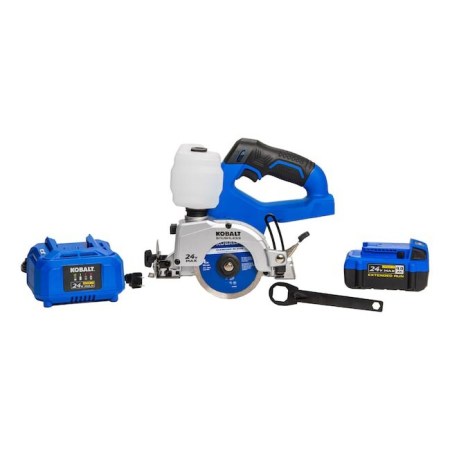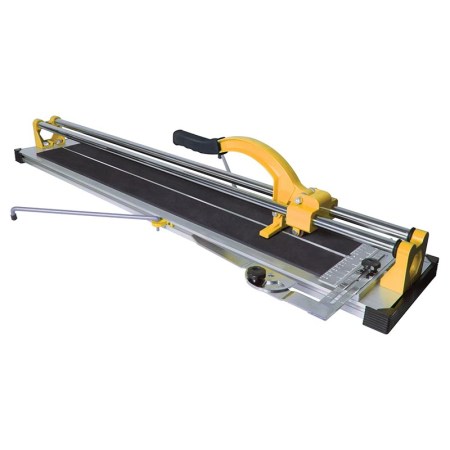We may earn revenue from the products available on this page and participate in affiliate programs. Learn More ›
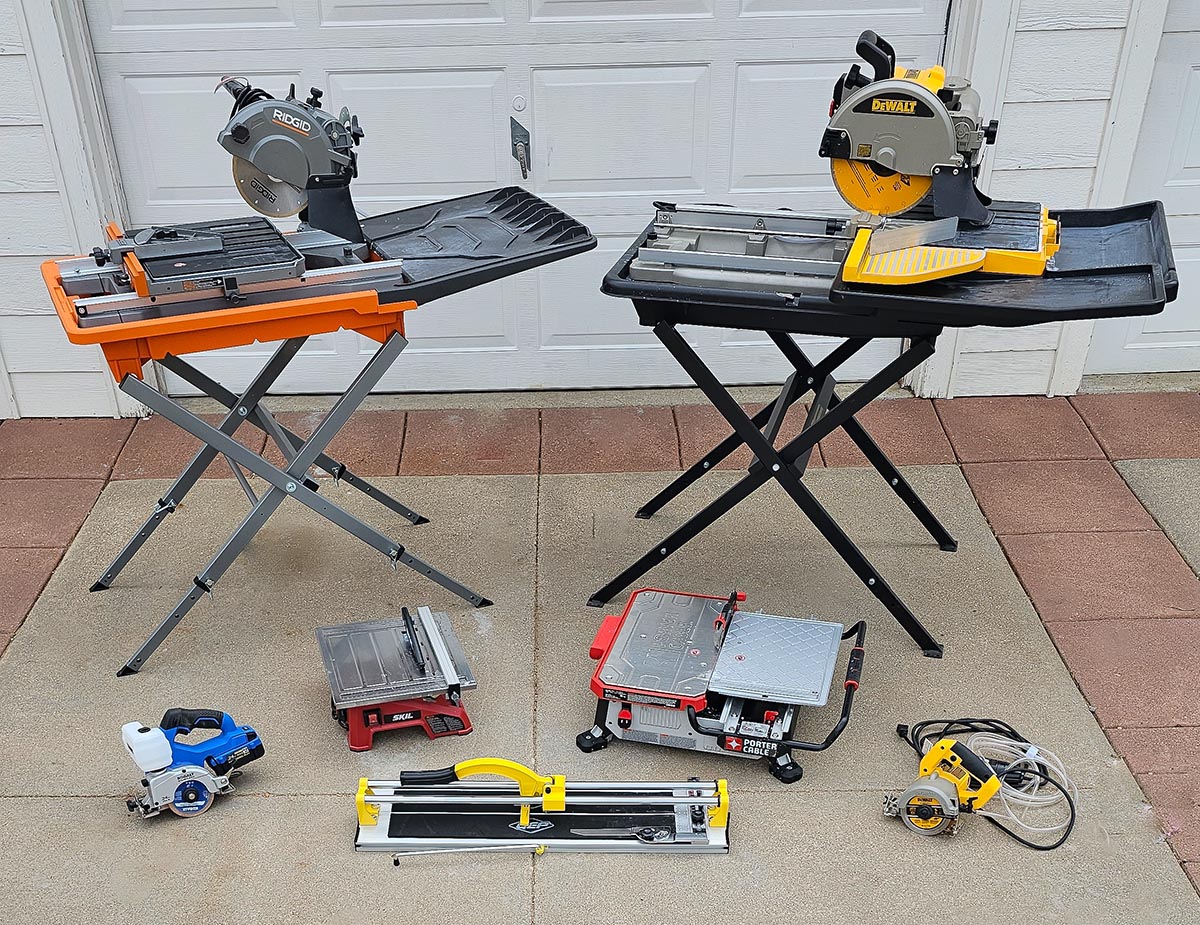
Achieving professional results from a tile project starts with thoughtful consideration—not only regarding tile selection but also in choosing the saw to be used. To make clean cuts through glass, ceramic, and other types of tile, a saw equipped with a diamond blade is crucial. However, factors like bed design, power, and a water-delivery system are equally important to ensure a successful project.
Water plays a vital role in the performance of many tile saws, reducing friction, noise, and dust while extending the blade’s longevity. Additionally, the importance of a sliding bed should not be underestimated as it stabilizes large format tiles, enabling precise cuts. In our hands-on testing, we evaluated the functionality of these features as well as several others.
After rigorously testing several of today’s best-selling tile saws, each of the following models earned a spot on our lineup. Ahead, discover shopping tips, recommendations, and all you need to know to find the best tile saw for your project.
- BEST OVERALL: DeWalt D24000S 10-Inch Wet Tile Saw With Stand
- RUNNER-UP: Porter-Cable PCE980 7-Inch Table Top Wet Tile Saw
- BEST BANG FOR THE BUCK: Skil 3540-02 7-Inch Wet Tile Saw
- BEST PORTABLE: DeWalt DWC860W 4⅜-Inch Wet/Dry Handheld Tile Cutter
- BEST EXTENDED CUT: Ridgid R4041S 8-Inch Wet Tile Saw
- BEST HANDHELD KIT: Kobalt KTSH 4024A 4-Inch Handheld Cordless Tile Saw
- BEST MANUAL: QEP 10630 24-Inch Manual Tile Cutter
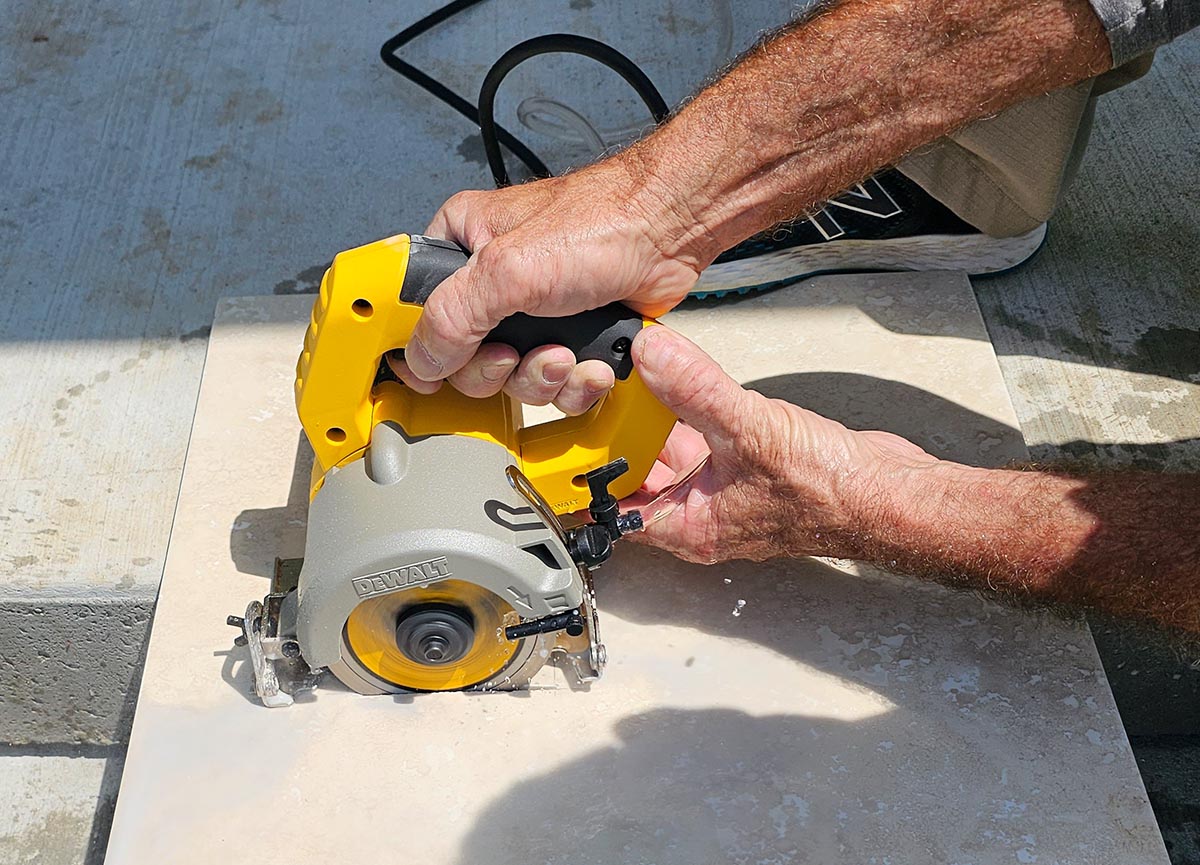
How We Tested the Best Tile Saws
A good tile saw makes accurate cuts on a variety of tile types. When selecting models for our hands-on testing, we researched more than 25 top models. We looked at a range of features—from lightweight, handheld options that are ideal for cutting a single tile or two on the fly to robust models suitable for repeated, heavy-duty tile cutting. We chose models in all price ranges and power levels to suit everyone, from highly skilled professionals to DIYers just starting out.
In the testing phase, we examined several key features. We noted how easy it was to assemble the saws (where applicable). Then we tested them on various tile materials, including ceramic, porcelain, glass, and travertine stone, evaluating each model for its intended cutting purposes.
We looked at each saw’s functions, making rip (straight) cuts and diagonal cuts using miter gauges. We observed how well their water systems reduced dust and carefully evaluated each saw’s build quality, overall power, and the types of tiles best suited for each model.
We then awarded each saw points based on a rubric. The better a saw performed, the more points it received. After completing the testing phase, we averaged the points to identify the top-performing saws in our lineup.
Our Top Picks
The following is our list of the models that excelled in our assessments, each matched to the category it best represents. Our top tile saws range in price, style, and intended use, but no matter what type of tile project you have in mind, there’s a saw here to meet your needs.
Best Overall
DeWalt D24000S 10-Inch Wet Tile Saw With Stand
See ItThe DeWalt D24000S wet tile saw is a powerhouse! With a 1.5-horsepower (hp) motor, this saw delivers outstanding cutting performance on multiple tile materials. In our tests, this DeWalt saw cut ceramic and travertine tiles with precision and ease.
With a capacity for up to 25-inch rip cuts, 28-inch plunge cuts, and 45-degree angle cuts, this tile saw offers remarkable flexibility for diverse project requirements. The assembly process was relatively convenient—we had the saw and water pan unit attached to the base in about 10 minutes using the included wrenches.
Stability and good tile support are critical when handling delicate and large-format tiles, and the DeWalt did not disappoint. It came equipped with a sturdy stand and steel legs that reduced unwanted wobbling during cuts, and the sliding table allowed us to feed the tiles through the blade smoothly. The blade’s high-efficiency water-flow system eliminated airborne dust and kept the blade cool while cutting. As a result, we didn’t experience any tile breakage, which can happen if a blade gets too hot. Another notable plus: The D24000S features a built-in ground-fault circuit interrupter (GFCI) switch on its cord, an added safety feature that reduces the risk of electrical shocks.
One minor downside of the DeWalt tile saw is that the included blade (a multipurpose tile blade) didn’t hold up as well as we would have liked when repeatedly cutting porcelain tiles, which are among the most challenging tiles to cut. Still, the blade performed admirably when cutting ceramic, glass, and travertine stone tiles. If you are looking to tackle a porcelain tile project, consider investing in a higher-quality blade, such as the DeWalt DW4762 diamond blade.
This tile saw comes at a higher price compared to other models we tested. However, the DeWalt D24000S’s extra power, quality build, and durable construction make it a worthwhile investment for professional tile setters and perfection-driven DIYers.
Product Specs
- Blade size: 10 inches
- Max rip cut size: 25 inches
- Plunge cuts: Yes
- Weight: 69 pounds
Pros
- 1.5-hp motor delivers exceptional cutting performance
- Versatile cutting options, including up to 25-inch rip cuts, 28-inch plunge cuts, and 45-degree angle cuts
- Water flow on the blade completely eliminates airborne dust for a cleaner working environment
- GFCI switch on the cord to protect against electrical shocks
Cons
- Included blade may not withstand extended cutting of porcelain tile
- Higher price may not be worth it for those with limited tiling needs
Get the DeWalt D24000S tile saw at Amazon, Lowe’s, The Home Depot, Acme Tools, or MSC.
Runner-Up
Porter-Cable PCE980 7-Inch Table Top Wet Tile Saw
See ItThe Porter-Cable PCE980 wet tile saw features a stainless steel table for greater longevity, half of which slides to stabilize tiles during cutting. Equipped with a 1-hp motor, this saw delivers sufficient power for most tile-cutting tasks, although it’s not designed to tackle large-format tiles or extensive jobs. The PCE980 can handle up to 17-inch rip cuts, and the included miter gauge makes it easy to create accurate diagonal cuts.
This tile saw has a 7-inch blade and an enclosed water reservoir for dust control and blade longevity. It excelled when we cut ceramic and travertine, delivering clean results without chipping. However, cutting porcelain tile proved slow, although it did get through those tiles without causing any chips.
While the water reservoir effectively controlled dust and kept the blade from overheating, we would prefer a water pump directing water right onto the blade. While this reservoir model performed very well, water did run across the stainless steel table and onto the floor, making this model best suited to outdoor use.
We also found that the splash guard slightly obstructed a clear view of the cutline, a design flaw shared among similar models on the market. With some practice, we accurately gauged where the blade would cut and achieved precise results. At 27 pounds, the PCE980 can get heavy to carry, so it would be nice if Porter-Cable added a set of wheels to make this saw a pull-along model.
Product Specs
- Blade size: 7 inches
- Max cut size: 17 inches
- Plunge cuts: No
- Weight: 27 pounds
Pros
- Durable stainless steel top will withstand rigorous and continuous use
- Sliding-table design increases stability for making precise cuts on tile
- Comes with a miter gauge for making diagonal cuts
- Incorporates a water reservoir basin for controlling dust and cooling the blade
Cons
- Blade splash guard slightly obscures the cutline but helps keep water from splashing everywhere
- There’s no GFCI switch on the cord, but the saw seems very well sealed
- Comes with a fixed blade and table, so it does not cut bevels
Get the Porter-Cable tile saw at Amazon, Lowe’s, Walmart, Target, Acme Tools, or MSC.
Best Bang for the Buck
Skil 3540-02 7-Inch Wet Tile Saw
See ItThe 7-Inch wet tile saw from Skil is a budget-friendly gem tailored to assist homeowners and DIYers in tackling small projects, such as backsplashes and craftwork. We found this affordable wet saw practical and precise when cutting ceramic and glass tiles. Best of all, it won’t break the bank.
This compact wet saw can handle up to 12-inch rip cuts and has a miter gauge for accurate diagonal cuts. Its stainless steel worktop is a standout feature that should outlast other budget models made with cheaper materials. You won’t find a sliding table at this price point, but with a bit of practice (and the adjustable fence), you’ll be making straight cuts in no time. The worktable is also adjustable, so you can create bevels from 0 to 45 degrees. Another plus: The splash guard sits high enough that we could clearly see our cutlines while cutting.
The water reservoir eliminated all airborne dust, but we found quite a bit of water ran across the table’s surface and off the side of the saw instead of back into the reservoir. As a result, we recommend keeping a good eye on the water level in the reservoir because we had to add water twice to ensure the level was high enough to keep the blade wet and cool.
We didn’t successfully cut porcelain tile with this saw—it just didn’t have enough power—but it’s also not designed for that purpose. It’s portable, lightweight, and does a good job cutting softer tiles up to 12 inches long. A cord winder on the side makes for easy cord storage, but it doesn’t come with a GFCI breaker switch.
Product Specs
- Blade size: 7 inches
- Max rip cut: 12 inches
- Plunge cuts: No
- Weight: 18 pounds
Pros
- At just 18 pounds, this model is lightweight and portable; great for jobs on the go
- Made from durable stainless steel materials; easy to maintain and wipe clean
- Miter gauge and adjustable rip fence make this ideal for consistent straight and diagonal cuts
Cons
- Some water may run across table surface and off the sides instead of into the reservoir
- Not suitable for cutting hard tile material, such as porcelain
- Does not make plunge cuts and does not have a GFCI switch
Get the Skil tile saw at Amazon, Lowe’s, Walmart, or Menards.
Best Portable
DeWalt DWC860W 4⅜-Inch Wet/Dry Handheld Tile Cutter
See ItTabletop tile saws are the industry standard for cutting loose tiles, but what happens when the tiles you need to cut are already installed? Or what if you have just one tile to trim and you don’t want to take time to set up a tabletop tile saw? A handheld tile saw is a nifty solution.
The DeWalt DWC860W, a 4⅜-inch handheld tile saw, is a handy little tool, and its portability is a big plus for cutting on the fly. This is the first time we’ve used a handheld wet tile saw since they’re a relatively new concept. We attached its 12-foot water tube to our garden hose, and as we cut, the tube fed a stream of water onto the blade to eliminate dust and keep the blade cool. The DWC860W is also designed for dry cutting, but we generated a lot of dust during dry cutting and needed to wear dust masks.
Equipped with a robust 10.8-amp motor, this compact saw delivers exceptional cutting power—it is a DeWalt, after all. In our tests, it cut through ceramic, glass, and travertine stone. We cut through a brick paver on a whim, and it sliced right through. Its premium blade even cuts through porcelain tile, though at a slower rate. The DeWalt handheld saw also cuts bevels up to 45 degrees, making it convenient for cutting mitered corners from tile.
Since the DeWalt DWC860W is essentially a circular saw with a tile blade (and those are go-to picks for cutting tiles that are already installed), we tried it out indoors, but it produced quite a bit of excess water. In an actual work situation, however, a second worker with a wet/dry vacuum would probably follow behind and suck up the water.
At just 6.6 pounds, the DWC860W is highly portable and comfortable, and its rubber over-mold gives it a nonslip grip. A GFCI switch on the cord adds a measure of safety against electrical shocks.
Product Specs
- Blade size: 4⅜ inches
- Max rip cut: No limit
- Plunge cuts: Yes
- Weight: 6.6 pounds
Pros
- Compact, lightweight, and easy to transport at 6.6 pounds
- 12-foot waterline reduces dust and keeps the blade from getting hot
- Versatile beveling up to 45 degrees for making mitered tile corners
Cons
- Since this is a handheld tool, making precise cuts can be challenging
- Some may find the 4⅜-inch blade limiting for cutting larger tiles or slabs
Get the DeWalt DWC860W tile saw at Amazon, Lowe’s, The Home Depot, Acme Tools, or MSC.
Best Extended Cut
Ridgid R4041S 8-Inch Wet Tile Saw
See ItThe Ridgid R4041S 8-inch wet tile saw is a powerhouse. It has a 12-amp motor that powers through ceramic, glass, and travertine stone tiles. It even cut through porcelain with ease and precision. This saw’s impressive features and capabilities make it a go-to choice for professional contractors and avid DIYers.
With an oversize cut capacity, this saw can handle 24-inch rip cuts and 18-inch diagonal cuts. Those cuts are substantial enough to meet most needs, but one of the neatest features of this Ridgid saw is a drop-gate fence that allowed us to cut even longer tiles. Just be aware that cutting longer tiles may require more than one worker to support the tile so it doesn’t shift.
This saw comes with a die-cast aluminum sliding table that’s solid and sturdy, and it has a nonslip surface to help keep tiles stable while cutting. An optimized water-nozzle system, guard baffle system, wrap-around rubber splash guard, rear water tray, and isolation wall work together to provide maximum water efficiency and keep the water in the tray—not all over the workshop.
The R4041S also has an adjustable stand that folds out quickly, and the saw bed sits right on top. No assembly is required to set it up or take it down to move. At 49 pounds, this is a pretty heavy saw, but if you’re cutting lots of tiles—or large format tiles—it’s tough to beat the stability.
Product Specs
- Blade size: 8 inches
- Max cut size: Unlimited
- Plunge cuts: Yes
- Weight: 49 pounds
Pros
- Innovative drop-gate fence allows you to rip plank tiles of unlimited length
- Optimized water system and baffle guard system keep the jobsite free from splashes
- Folding stand is convenient; just fold out and place the saw system on top
- Powerful 12-amp motor provides ample oomph for cutting tiles and even pavers
Cons
- Some users may find the saw’s weight cumbersome, especially during transport
Get the Ridgid tile saw at The Home Depot.
Best Handheld Kit
Kobalt KTSH 4024A 4-Inch Handheld Cordless Tile Saw
See ItThe Kobalt 4-inch handheld cordless tile saw is a game changer. It’s battery-powered and features a little onboard water reservoir, so you can run it even in remote locations without electricity. Its design eliminates the need for cords and hoses that can tangle or cause tripping.
Powered by a Kobalt 24-volt battery, this handheld tile saw delivers impressive cutting performance with a powerful brushless motor. In our tests, it cut quickly through ceramic, glass, and travertine stone tiles. It was a little slower cutting through porcelain, but it made it through and left clean, precise edges. The tile saw’s stainless steel shoe allows for easy adjustments to various depths and bevels up to 45 degrees, offering flexibility for tackling a variety of cutting needs.
We really like the innovative water-feed system on the Kobalt handheld saw. Pressing the trigger automatically supplies water to the blade, and while it wasn’t a lot of water, it was enough to eliminate dust and keep the blade cool. We could use the saw indoors to cut installed tile flooring without making too much of a mess. Still, if you’re using it indoors, you’ll probably want a wet/dry vacuum handy to suck up any excess water.
Battery runtime will vary based on the type, size, thickness, and composition of the tile being cut. In our tests, we cut ¼-inch ceramic, glass, and porcelain tiles along with ⅕-inch travertine stone tiles. Using the included high-capacity 4-amp-hour battery, we made dozens of test cuts without losing any power. Blade-change wrenches store conveniently on the tool, adding to its user-friendly design.
Product Specs
- Blade size: 4 inches
- Max cut size: Unlimited
- Plunge cuts: Yes
- Weight: 5.7 pounds
Pros
- Cordless design offers the ultimate in portability and freedom to work in remote locations
- Included 4-amp-hour battery provides enough runtime to complete most small to medium projects
- Water system features onboard reservoir, so no need to hook a water tube to a hose
Cons
- You may want to invest in a second battery to avoid stoppages during large projects
Get the Kobalt tile saw at Lowe’s.
Best Manual
QEP 10630 24-Inch Manual Tile Cutter
See ItWet tile saws are inherently messy, but QEP’s 24-inch manual cutter is a dust-free, splash-free alternative. This saw uses a tungsten-carbide cutting wheel to score the tile and a handle that exerts pressure on both sides to snap the tile into two pieces.
This QEP tool can cut 24-inch flooring tiles or 16-inch tiles at a 45-degree angle. It offers a reliable and versatile performance designed to handle ceramic and porcelain tiles efficiently. By following the trusted score-and-snap process used by tile setters for decades, it makes quick work of cutting tiles without the need for a power tool.
One of the standout features of the QEP model is its dual chrome-plated steel rails with linear ball-bearing slides, which contribute to smooth and precise scoring on large tiles. We tested the QEP on several types of tiles, and it performed best with ceramic and porcelain. We didn’t have much luck with glass tiles, which came away with uneven and dangerously sharp edges. But the broad aluminum-alloy base, heavy-duty rubber pads, and cutting table extensions added stability, especially when working with larger tiles.
The tile cutter has a ⅞-inch titanium-coated tungsten-carbide scoring wheel that makes consistently clean straight scores on the tiles. It’s paired with a straight-edge adjustable measurement guide that helps align tiles accurately for precise cuts.
Product Specs
- Blade size: ⅞-inch scoring wheel
- Max cut size: 24 inches
- Plunge cuts: No
- Weight:16.2 pounds
Pros
- Manual tools produce less mess (water and dust) compared to power tools
- Suitable for ceramic and porcelain tiles, providing versatility for various tile installation projects
- Wide aluminum-alloy base with side extensions offers stability when cutting large and heavy tiles
- ⅞-inch titanium-coated tungsten-carbide cutting wheel ensures smooth and durable scoring
- Straight-edge adjustable measurement guide enables accurate tile alignment for precise cuts
Cons
- Limited usability compared to power tool options; does not cut bevels
- Manual saws require some skill and practice to achieve consistently precise cuts, especially for beginners
Get the QEP tile saw at Amazon or The Home Depot.
Jump to Our Top Picks
What to Consider When Choosing a Tile Saw
There are several things to remember while shopping for the best tile saw. This section shares some of the most essential features to consider so you can choose the best tile saw for your work.
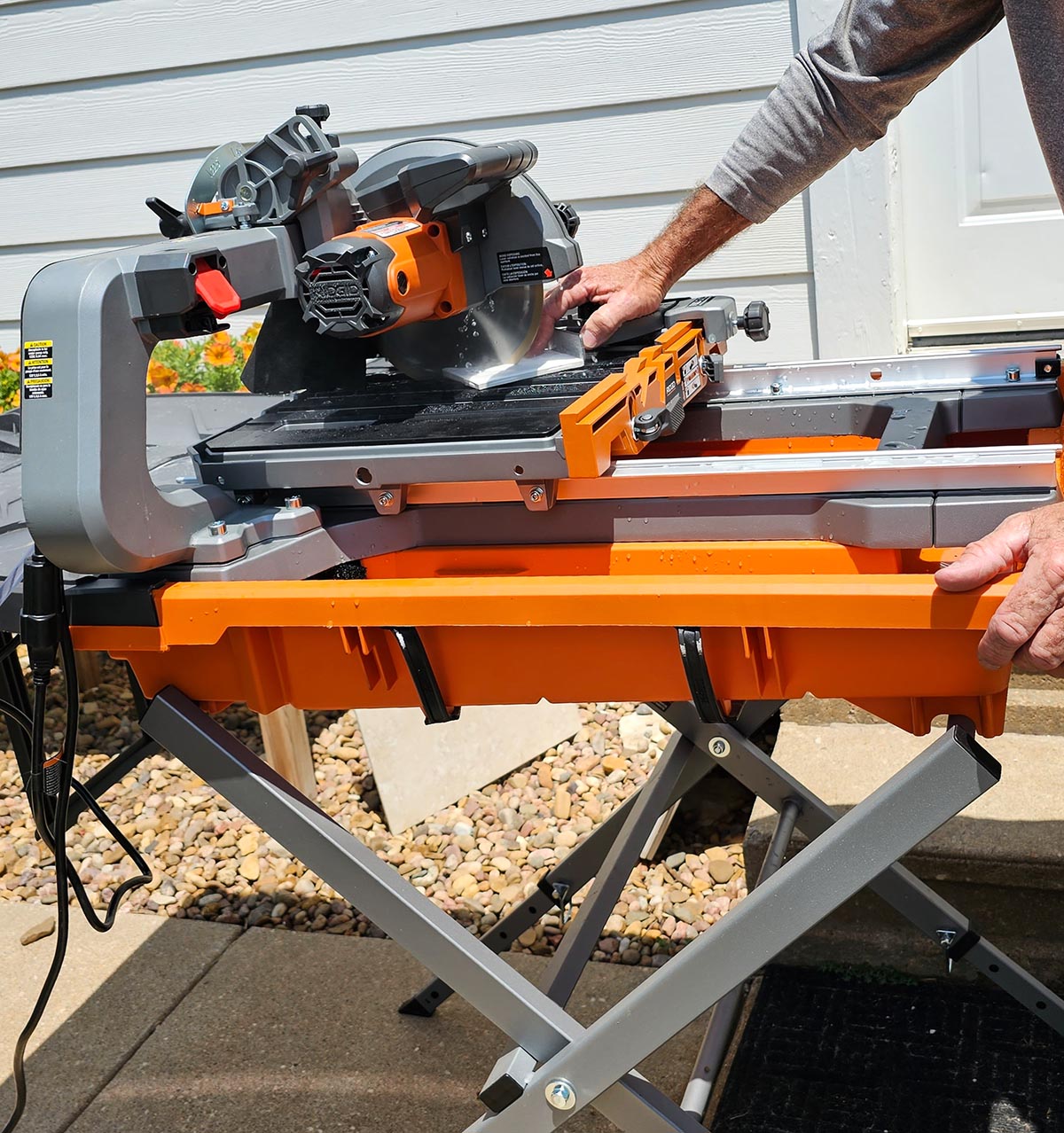
Cut Quality and Accuracy
Straight and clean tile edges affect the look of a space, so consider the saw’s cut quality and accuracy to achieve the desired design. Some saws have features that make accurate cuts easier to achieve.
When it comes to wet saws, consider a model that provides some type of guide for creating straight cuts. A guide could be an adjustable table sawlike fence, a sliding bed that holds your tile in place while cutting, or a miter gauge that secures the tile at the correct angle for a diagonal cut. Also, adjustable bevels allow you to make accurate outside and inside corners, which are ideal for using tile as base molding.
For DIYers looking to cut out the cost of a professional installation, keep in mind that the accuracy of handheld and grinding tile saws is primarily up to your ability. However, some handheld saws have laser guides and attachments to guide the saw as you cut.
Blade Quality
Using a low-quality tile blade is the quickest way to exceed your tile budget and frustrate yourself. Poor-quality blades can chip the tile, slow the process, and cause more headaches than the initial savings are worth.
Chances are, your saw will come with a multipurpose diamond-grit blade necessary for cutting tile. However, some low-quality blades that come with budget-friendly saws can wobble a bit while cutting, causing inconsistent tile edges. They also wear out quickly. If you’re struggling to achieve perfect results, it might be the blade’s fault, not the saw’s or yours.
Upgrading the blade can help make an inexpensive saw cut better, so it’s something to keep in mind if you’re getting frustrated.
Type of Tile
The type of tile you’re using is a factor when choosing the best tile saw. Some materials require extra features to create the best results.
Ceramic and porcelain are very common types of tile, but while ceramic is easy to cut, porcelain is much more challenging and requires a high-quality diamond-encrusted blade. Marble is too soft to snap, so a manual tile scorer won’t be your best choice there. Some natural materials, like terra cotta, stone, and others, tend to be very dusty and require a wet saw, as the mess can be unbearable and make it difficult to see what you’re doing.
A handheld wet/dry tile saw is the most versatile tile saw, and it will make most basic cuts. A wet saw follows closely behind and creates more accurate cuts. If you’re unsure about the type of saw your tile requires, these two styles will work for almost any tile and situation.
Water Feed
As mentioned earlier, water can help make tile cutting a much more enjoyable process. While splashes can be messy, the trade-offs are quick and accurate cuts and working in a low-dust environment. In addition, water reduces the friction the blade creates as it’s cutting, so there’s less risk of tiles cracking from excess heat buildup.
How the water feeds onto the saw blade varies. Many wet saws have no feed, instead relying on the blade dipping into the water basin below the saw’s surface. Some call this a “wet-blade” saw. Others pump water onto the blade. Pumps are often more efficient, as they ensure plenty of water directly on the cut, but these models can be more expensive.
If you’re concerned about mixing water with electricity, that’s understandable. Wet saw motors are sealed from splashes, so there’s minimal risk of a shock from a wet saw. Additionally, some of the newer models come with GFCI switches on their cords that shut off power to the saw in the event of an electrical problem.
Types of Tile Saws
If you DIY your tile project, you’ll undoubtedly save on professional tile installation costs. As you shop for the best tile saw, you’ll notice there are a few types of saws available. Each type works differently, so learning about the differences will help determine which will work for your project.
Wet Tile Saw
A wet tile saw is one of the most effective ways to cut tile. These electric saws use a spinning diamond-embedded blade to cut tile accurately and quickly. Wet saws look similar to table saws (or circular saws) but with the addition of a water basin or water-feed tube. The water cools the saw blade while keeping airborne dust to a minimum.
Much like table saws can bevel wood, it’s possible to cut bevels and angles on some tile saws. This may require adjusting the deck or topside of the saw or tilting the blade. Many wet saws have sliding beds or adjustable rip fences, increasing user control. The size of the sliding bed varies from model to model, and a larger bed can make cutting large-format tiles easier.
Handheld Saw
A table-type wet saw isn’t the only option for cutting tile quickly and accurately. Electric or battery-powered handheld models can cut a tile to size or even cut bevels or shapes around moldings and cabinets. They work best for medium to large tiles.
Handheld tile saws look and work a lot like a circular saw. They use diamond-embedded blades like other wet saws, though they come in both wet and dry versions. Wet versions usually feature a hose attached to the saw to keep the blade lubricated and keep the dust down, while dry versions just let the dust fly.
Handheld tile saws let you conquer tight angles and irregular shapes or curves. They can also be easier and quicker to set up, making them desirable for jobs that require just a cut or two. Their downside is the need to develop an accurate technique, which can take some practice. Also, these saws can be pretty messy since they don’t have water basins to catch water, so you’ll probably want to use them outside or have an assistant use a wet/dry vacuum to suck up the water as you cut.
Grinding Wheel
Some tile professionals prefer an electric grinder fitted with a diamond-embedded wheel for cutting tile. A wheel can be an attractive option if you already own a grinder. These wheels make the grinder work similarly to a handheld saw but with some trade-offs.
Grinders have plenty of power and are great for stubborn materials like granite. However, they can be awkward to hold, as they’re slightly less balanced than handheld saws. Also, they don’t have a flat surface for the tile to sit against, so you can inadvertently cut bevels if you aren’t paying attention.
Working with a grinder is messy. It’s best to have a helper hold a shop vacuum close to your spinning blade if you prefer to keep dust and debris to a minimum.
Tile Cutter
The most common and inexpensive way to cut tiles to shape involves a tile cutter, sometimes called a “scorer.” Without electricity or a battery, these can be used to make straight cuts across certain types of tile.
If you’re installing porcelain or ceramic tile, cutters are an excellent way to make quick, relatively mess-free cuts. These tools work by scoring a cut line with a small tungsten-carbide blade across the surface of a tile. You then use a lever to apply pressure to both sides of the scored line. When you apply sufficient pressure, the tile snaps along the line.
This method creates very little dust, though small bits of glass can be left behind. Also, since this method depends on breaking the tile, the edges are less cleanly cut than with a diamond-embedded power saw. They also cannot make curves or intricate cuts.
FAQs
While cutting tile requires some special tools, it doesn’t have to be an intimidating task. With a little experience, you’ll be able to cut tiles with your new saw in no time. The result will be an excellent finish for your next renovation. Here are some of the most frequently asked questions about tile saws and how they work.
Q. Do I need a wet saw to cut tile?
No, you don’t, but a wet saw is usually the best option. If you don’t use a wet saw, you’ll have to deal with lots of dust. Alternatively, you can use a diamond-embedded blade in a grinder or handheld saw.
Q. Can I use a Dremel to cut tile?
Dremel offers several diamond-embedded cutting wheels for its rotary tools. They’ll work, but it might take you longer, and it could be more difficult to cut a straight line. That said, Dremel rotary tools are excellent for creating outlet cuts and curves.
Q. What size tile saw do I need?
The most common blade sizes are 4½, 7, and 10 inches. All three will work for most renovation work, though 4½-inch blades are much cheaper to replace than 7- or 10-inch models.
Meet the Tester
Glenda Taylor is a product tester and writer specializing in the construction, remodeling, and real estate industries. She and her husband own a general contracting company, and Taylor is experienced in both residential and commercial building applications. She tests a wide range of power tools as well as other home improvement, household, and lawn-and-garden products.
Additional research provided by Tom Scalisi.
